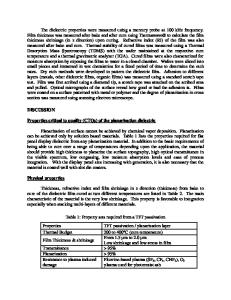Carbon-Nanotube Transistor Arrays Used for Fabrication of Multistage Complementary Logic Devices and Ring Oscillators
- PDF / 518,363 Bytes
- 2 Pages / 612 x 792 pts (letter) Page_size
- 69 Downloads / 308 Views
exponential decay, representing a liquid phase. At 330 K, the positional correlation function remained isotropic but the orientational one showed algebraic decay, a signature of the hexatic phase. At 290 K, the system became a two-dimensional hexagonal crystal, showing quasi-long-range positional order and long-range orientational order. The scaling of the correlation functions was consistent with KTHNY theory. The melting transition was second order when the pores contained one layer of molecules and became weakly first order for pores containing two layers. The researchers attribute the change to interaction between defect configurations in the two layers. Differential scanning calorimetry (DSC) measurements of CCl4 and aniline in an activated carbon fiber with slitshaped pores narrowly distributed around a mean size of 1.4 nm showed peaks near temperatures predicted in the simulations. Nonlinear dielectric effect (NDE) signals diverged with a scaling consistent with the theory. Dielectric relaxation spectroscopy (DRS) of adsorbed aniline, a dipolar fluid, showed sharp changes, indicating phase transitions near the predicted temperatures. The orientational relaxation times of the adsorbed molecules were typical of a hexatic phase between 298 K and 324 K. Below that range, the time scales were typical of a crystal, and above it, they were typical of a liquid. ELIZABETH A. SHACK
of positively charged cations and electrons with properties determined by the topology of the pores in the host matrix. In traditional crystallography, longrange order and symmetry, specifically the repeating three-dimensional (3D) patterns in the crystals, give rise to sharp Bragg peaks in the x-ray powder diffraction pattern, which are then used to determine the atomic structures. Materials constructed at the nanoscale, however, lack this longrange order and often accommodate a large number of defects and local disorder. The result, said Petkov, is that the diffraction patterns of nanocrystals are much more diffuse with few, if any, Bragg peaks. To overcome this problem, the team of scientists employed the PDF technique, a nontraditional experimental approach, to read between the Bragg peaks of data produced by traditional x-ray powder diffraction experiments. With the PDF technique, the scientists revealed direct structural evidence that cesium is intercalated in the nano-sized pores of the silicon oxide zeolite in the form of positively charged cesium ions arranged in short-range-order
zigzag chains. This verifies that CsxSi32O64 is a room-temperature stable inorganic electride, the scientists said. “Electrides are novel materials that are just beginning to be studied,” said Petkov. First results show that they could be used as reducing materials in chemical synthesis of other materials and that they have useful electronic properties such as low-energy electron emission.
Carbon-Nanotube Transistor Arrays Used for Fabrication of Multistage Complementary Logic Devices and Ring Oscillators Carbon nanotubes are expected to be the most pr
Data Loading...










